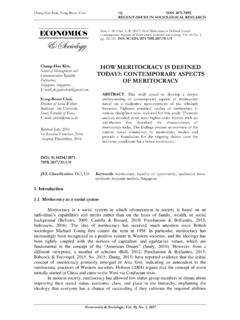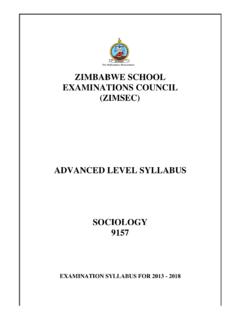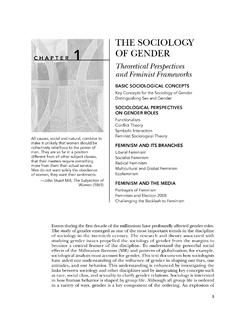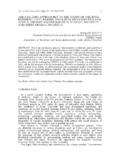Transcription of ON GENDER STEREOTYPING AND ... - Economics & Sociology
1 Ilona Kiau ien , Dalia treimikien , Dainora Grundey ISSN 2071-789X RECENT ISSUES IN sociological RESEARCH Economics & Sociology , Vol. 4, No 2, 2011 84 Ilona Kiau ien Department of Business Economics and Management Kaunas Faculty of Humanities ON GENDER STEREOTYPING AND EMPLOYMENT ASSIMETRIES Vilnius University E-mail: Dalia treimikien Department of Business Economics and Management Kaunas Faculty of Humanities Vilnius University E-mail: Dainora Grundey Department of Management Faculty of Politics and Management Mykolas Romeris University E-mail: ABSTRACT. Every day women face obstacles which do not allow them to reveal their possibilities in payable workplaces. There exists a preconception and women s discrimination that defines and activities different and most frequently narrower possibilities for their existence related to their participation in labour market.
2 Women are most often valued not according to their personal abilities, but following the settled stereotypes that they possess poorer abilities and they are not able to perform work that requires responsibility or that women are less creative, etc. In the scientific literature, stereotypes of GENDER roles are defined as a cultural and social approach towards the very thing that is traditionally considered being masculine and feminine roles and functions. It is stated in the article that the stereotypes, formed in the society might influence women s and men s work choice as well as create the labour market that is divided under genders, and what is more the stability of woman s social status iniquity necessarily fosters addressing to the culture as one of the most significant reasons, those restrict the confirmation of woman s and man s equality in the society.
3 The purpose of the article is to review the GENDER stereotypes and their impact on women and men in the labour market. Women experience pressure due to the necessity of their social and economic status; women s career development is more complicated and problematic than men s. The analysis of statistic data, performed in the article revealed that the formed level of women s employment is lower than men s. There is noticed powerful segregation of labour market and undervaluation of women s work. Men and women are spread in different professional groups, and there are delegated less responsible and lower qualification works for women. Thus in order to perform the implementation of GENDER equality in labour market, it is needed to change traditional GENDER roles, despite the fact that their change or elimination is always related to the change of collective beliefs and that is a result of collective actions determining qualitative changes of the entire social life.
4 Received: June, 2011 1st Revision: September, 2011 Accepted: October, 2011 JEL Classification: D63, J16, J21, J24 Keywords: GENDER stereotypes, employment, GENDER , culture, GENDER equality. Ilona Kiau ien , Dalia treimikien , Dainora Grundey, On GENDER STEREOTYPING and Employment Assimetries, Economics & Sociology , Vol. 4, No 2, 2011, pp. 84-97. Ilona Kiau ien , Dalia treimikien , Dainora Grundey ISSN 2071-789X RECENT ISSUES IN sociological RESEARCH Economics & Sociology , Vol. 4, No 2, 2011 85 Introduction During different life stages, there differ women s and men s possibilities to participate in labour market and they depend on many factors. Women and men face versatile problems when they overcome first difficulties towards their professional activities, obtain some experience, entrench successfully (or not) in labour market and climb (or not) heady career ladder.
5 Although one of the most significant targets of the modern society, securing its advanced social, cultural and economic evolution, is to guarantee the equality of all society members, women s and men s possibilities concerning the participation in labour market differ. Historical experience reveals that neither economical welfare nor advanced political decisions, do not secure equal possibilities for women and men unconsciously. The greatest obstacle turns to be human beings stereotype attitudes concerning man s and woman s role in the society (Jankauskait and Mackevi i t , 2005). In the scientific literature it is highlighted that in the society there is still predominant approach that a woman s performance is associated with private life home and family, and public field is assigned to a man, firstly realizing it as a professional performance (Jankauskait , 1999).
6 In every society, the women s and men s behaviour is perceived and stereotyped differently, and that is determined under the certain cultural level. The concept of culture is defined differently, however, in the scientific literature it is sought to find out how much and in what ways culture impacts individuals or their group activities. In terms of economic development, it is important that culture, including values, norms of behaviour and material products, impacts lifestyle and behaviour ( iburien and Gu inskien , 2007). It is considered that there exists a tendency to teach and learn the corresponding behaviour related to a GENDER role. Nevertheless, curriculum depends on the certain society. In the society there women are less dependent economically; there is less stereotypical differentiation of GENDER roles.
7 The purpose of the article is to review the GENDER stereotypes and their impact on women and men in the labour market. Research tasks are formulated as follows: to define the concept of GENDER stereotypes; to analyse women s and men s employment rate gap; to identify the relationship between cultural factors and GENDER equality in the labour market. The research methods are the survey and analysis of the scientific literature, scientific literature systemization, and mathematical statistics methods. 1. Literature Overview: The Perception of GENDER Stereotypes Human beings reside in the world of cultural stereotypes, superstitions and naturalized attitudes; those cannot be eliminated under any legal acts currently. According to Tere kinas s (2004) point of view, there are especially many attitudes like those, related to women and men, their roles in family and society.
8 Since the very childhood, human beings are brought up and educated in the surroundings of versatile stereotypes, a woman s job is in the family , a man has to support family and a woman has to look after children and educate them , men do not cry as they are powerful , a man is a defender, a courageous and fearless fighter, and a woman is dependent on a man, passive and full of fear . GENDER stereotypes are cultural and social attitudes towards what is traditionally considered male or female roles and functions (European Commission, 2009). According to Valackien and Kra enkien (2007), GENDER role stereotypes are internal attitudes related to women s and men s favourable places in the society in terms of their functions and social Ilona Kiau ien , Dalia treimikien , Dainora Grundey ISSN 2071-789X RECENT ISSUES IN sociological RESEARCH Economics & Sociology , Vol.
9 4, No 2, 2011 86 assignments. Such stereotypes are obstacles those are overcome in a most difficult way through the creation of basically new relationship in society and qualitatively new society; precisely stiff stereotypes are an origin of women s discrimination . There is predominant a belief among ordinary members of the society that GENDER role differences, naturalized in the society, are necessary and constant as they are determined biologically. It is considered that natural GENDER differences are much deeper than evident physiological ones and they involve the entire spectrum of psychical characteristics those are different for men and women ( imanskien , 2006). A GENDER stereotype consists of beliefs about the psychological traits and characteristics of, as well as the activities appropriate to, men or women.
10 GENDER roles are defined by behaviours, but GENDER stereotypes are beliefs and attitudes about masculinity and femininity. The concepts of GENDER role and GENDER stereotype tend to be related. GENDER stereotypes are very influential; they affect conceptualizations of women and men and establish social categories for GENDER . These categories represent what people think, and even when beliefs vary from reality, the beliefs can be very powerful forces (Brannon, 2000). Stereotypes are ubiquitous and continue to influence behaviour, but it is not easy to pinpoint how far they stand for genuine preferences, how far they express social norms or how far they are used to surrogate information (Bettio and Verashchagina, 2009). GENDER stereotypes may influence women s and men s choices of studies and jobs, and may lead to a GENDER -segregated labour market.












